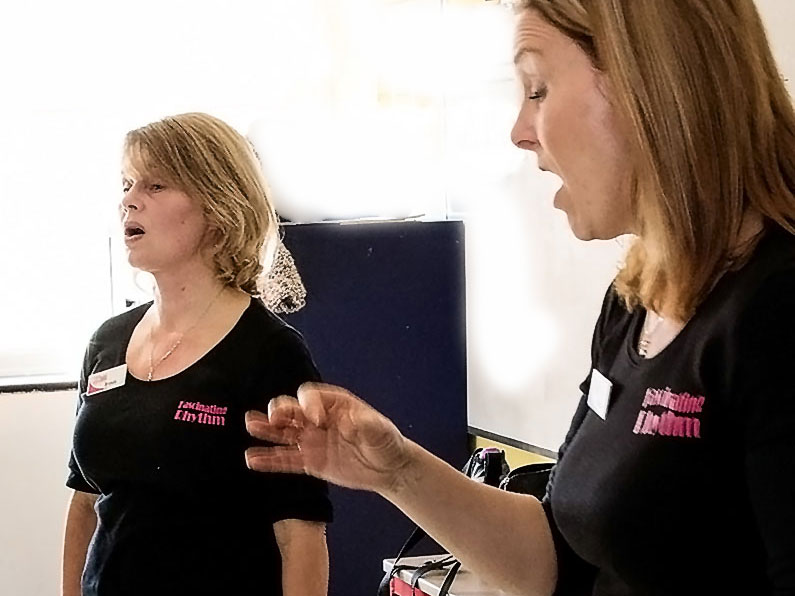Why Warm Up
Getting in the zone for singing
Fascinating Rhythm is renowned across Bristol and South Gloucestershire for close-harmony a cappella singing and our unique choral sound. We strive for musical excellence through regular rehearsals on Thursday evenings.
A crucial part of our rehearsal time involves getting ourselves ready to sing. Far from being a tedious slog that we have to get through as quickly as possible, Fascinating Rhythm’s warm-up sessions are as much about coming together and having fun as they are about exercising our voices.
Musical Director Jo, Assistant Director and Choreographer Wendy, and Baritone Section Leader (and vocal coach) Karen make sure our warm-ups are efficient, effective and fast-paced. So, we asked them to tell us why warming up is important and share their top tips for preparing to sing.
Turn up and tune in
Barbershop singing typically involves standing up and being in close proximity to others. When we first step onto the risers, we take a few minutes to get used to our surroundings and tune in to each other. Each singer has her own ‘spot’ on the risers, with a unique environment created by her neighbours’ voices and physical space confined by singers in front, behind, and either side. Before we start singing, we must assimilate into our space and tune in our bodies to what’s going on around us.
Stepping onto the risers also takes us away from the day we’ve just had, allows us to re-connect as a team, and puts us in the zone of ‘we are singing now’. Warming up acts as the next step in the process of relaxing our bodies and entering a state of readiness for making music. We are expected to be engaged and give 100% to our rehearsal from the first blow of the pitch pipe.
Fascinating Rhythm dedicates half an hour to warm up at the start of every rehearsal. We use this time to switch on our brains, position ourselves with good alignment for singing and pump some adrenalin. The way we warm-up sets the tone for our whole rehearsal – if everyone is fully engaged, we know we’re in for a good night!
Care for your voice
Singing uses the whole body, from the tiny muscles in and around the larynx to the major rib and abdominal muscles. Warm muscles are stretchy and soft and less prone to injury but, if you don’t warm up, you risk causing damage. So, think of yourself as a vocal athlete, exercise your voice like you would any other muscle and make warming up part of your daily routine. Jo recommends aiming for 20 minutes per day. You could even consult a vocal coach for some personal training and ask them to tailor a set of warm-up exercises to suit you.
Warming up also aligns your vocal instrument, eliminates any tension that could affect your voice, and improves vocal quality. A warm voice will be less likely to break or crack, less prone to throat bubbles, and more likely to stay on pitch and in tune. Gentle breathing and warm-up exercises are also a really nice thing to do for yourself – mindful and relaxing, a kind of self-care for singers!
Follow a warm-up routine.
Fascinating Rhythm follows a structured warm-up routine covering posture, breathing, pitch, performance, vocal techniques and vocal quality. Each element has a purpose in getting us ready to sing, and Wendy follows a similar approach with Junior FR (with an extra focus on having fun)!
1. Posture: We take a few moments to settle our bodies, noticing our posture and any areas of tension. Then, we gently mobilise our neck, shoulder and back muscles and do some side stretches before aligning our posture for singing.
2. Breathing: Most of us breathe all day long without thinking about it, but, as singers, we need to be more aware of how we can use the breathing apparatus to control our airflow. Shushing or hissing will exercise the abdominal support muscles, and we practise squeezing out every last bit of air before taking in a new breath. (Taking care not to make ourselves dizzy!)
3. SOVT (semi-occluded vocal tract) exercises: Singing is more intense and covers a broader vocal range than talking, so we start with lip trills (or ‘bubbling’) and humming up and down a few notes to get our vocal folds vibrating. Beginning somewhere comfortable in our vocal range, we gently extend out to a full scale or a simple tune.
4. Vocal quality: The voice makes a different type of sound according to where you ‘place’ it – for example, it can be nasal or throaty. As singers, we want to create a nice, resonant sound with open vowels.
5. Vocal techniques: We try out different ways to add interest to our singing (such as dynamics, staccato and legato, the enunciation of consonants) by singing some simple songs. We also use rounds or simple harmony tunes to get used to singing against different voice parts.
6. Performance: Barbershop singing has a visual performance aspect, and it can be surprisingly tricky to move and sing at the same time. So, we do something that engages the brain – like ‘say what I say and do the opposite’, which always ends up with everyone giggling!
The critical thing to remember about warming up is taking your time and doing it gently from a point of comfort. Warming-up isn’t about pushing yourself – if it feels too intense, ease back down.
Warm-up time is never wasted.
Multi medal-winning barbershopper Sally McLean (Musical Director of the White Rosettes) has coached Fascinating Rhythm on several occasions and praised our commitment to warming up because it helps us achieve our unique look and sound. Jo, Wendy and Karen make sure our warm-ups are accessible and inclusive to suit the range of skill across the choir, and explain what each exercise is for (without getting too technical!) so that everyone understands what to do and is able to join in. Our greatest achievement has been staying in tune as we work up and down the solfege scale, which took weeks of practice!
We encourage every singer to get enthusiastic about warming up! Don’t just stick to scales and arpeggios but think about what you enjoy singing and build it into your warm up time. Fascinating Rhythm love singing rounds and our current favourites are “Alfred the Alligator” (complete with lots of visual performance and vocal dynamics) and “Gin and Tonic” (which is excellent for practising consonants, articulation and synchronisation).
Warm-up with Fascinating Rhythm
Warming up can help you to maintain a healthy voice for as long as possible. So why not warm up with us? We’ve created a CD of warm-up exercises designed to help improve vocal range and perfect various singing techniques.
You might like to see other articles in the Fascinating Rhythm Insights series:
01 – Why singing is good for you!
02 – Making your performance authentic
03 – Enhancing performance through vocal expression
04 – Teamwork makes the dream work
06 – The New Members Guide to Joining a Choir During a Pandemic!
07 – Breathing to Sing
08 – Junior FR: how it started / how it’s going
09 – Singing is a Family Affair
10 – How we choose Convention songs
11 – Mixing it Up
12 – Love to Sing


